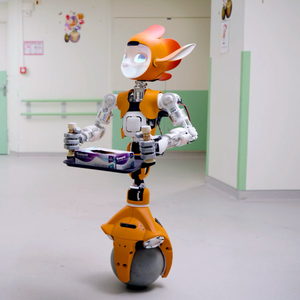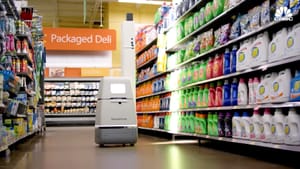As I sat this morning, I realized something - we're not in Kansas anymore. No, I'm not Dorothy from The Wizard of Oz, but I do find myself in an equally intriguing world where our golden agers aren't just playing bingo and knitting sweaters. They're living in an era where robots, once a figment of sci-fi imagination, are becoming a reality. A reality that's transforming their lives for the better.
From shortages of skilled caregivers to the monumental costs associated with long-term care, the struggle is real. And this is where our mechanical friends step in. They're here to revolutionize elderly care, and trust me, it's not as intimidating as it sounds.As I sat down to ponder the rise of robots in elderly care, I couldn't help but think of the famous line from Back to the Future,
"Where we're going, we don't need roads."
Except in our case, we're not time traveling (though wouldn't that be something?), but journeying through the fascinating timeline of robots in elderly care.
The advent of robots in elderly care didn't just pop out of the blue. It was a gradual progression, an evolution if you will, that stemmed from the broader field of robotics. Remember the first industrial robot, Unimate? Deployed in 1961, it was a game-changer in automating monotonous tasks in a General Motors plant. Well, we've come a long way from Unimate, but it's essential to remember that all this didn't happen overnight.
Fast forward to the 21st century, where we started seeing robots make a real impact in healthcare. 2009 marked a significant milestone with the approval of the da Vinci Surgical System, a robotic system designed to facilitate complex surgery. It was a game-changer, paving the way for robots to delve into the sensitive field of healthcare.
The shift towards elderly care came next. With the aging global population and a simultaneous shortage of caregivers, the need for an innovative solution was apparent.
Enter Paro, the therapeutic robot seal. Launched in 2003, Paro was an instant hit, offering emotional support and companionship to seniors, particularly those with dementia.
Then came robots like the Robear from Japan, an experimental nursing care robot capable of lifting patients, introduced in 2015. And we can't forget the ElliQ, an 'active aging companion' unveiled in 2018, designed to keep seniors active and engaged.
We're now in an era where robots are not just an experimental concept, but a practical tool in elderly care. And with advancements in AI and machine learning, the possibilities are endless. We're indeed going where we don't need roads. Instead, we need innovative minds, compassionate hearts, and of course, a touch of humor. After all, who says robots can't crack a joke or two?
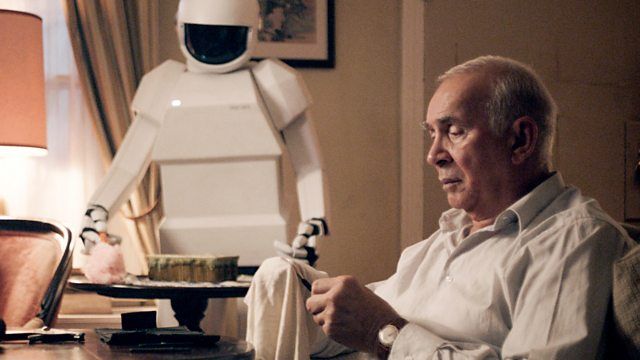
Let's kick things off with medication reminders. As we age, the number of pills we need to remember to take can start to resemble a game of bingo. Keeping track can be confusing, and the stakes are high.
Enter robotic pill dispensers like the Pria by Black+Decker. This little helper stores up to 28 doses and dispenses them on a set schedule. It even has a built-in camera and app connectivity for remote check-ins.
Then we have health monitoring robots. Imagine having a personal healthcare assistant who never sleeps. That's what robots like CarePredict offer. They learn a senior's daily patterns and can alert caregivers to any significant changes. So, if Granny usually bakes her famous apple pie at 3 PM, but one day she doesn't, CarePredict will raise an alert.
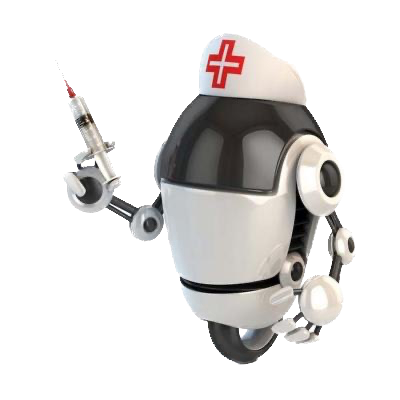
Companionship is another area where robots are making their mark. And no, I'm not talking about Wall-E and EVE's love story. I'm referring to robots like the aforementioned Paro and ElliQ, which provide companionship and cognitive stimulation. They're like pets but without the mess.
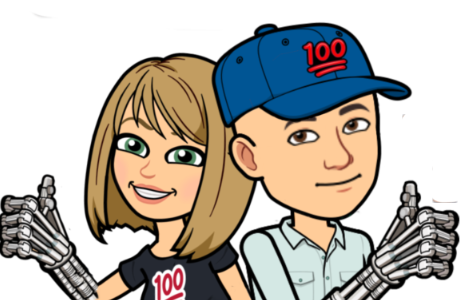
Mobility assistance is yet another area where robots are flexing their 'muscles'.
The Toyota Human Support Robot, for instance, can pick up objects, open curtains, and even fetch items for the elderly. It's like having a personal butler.
The beauty of these robotic applications is that they're not replacing human caregivers but rather augmenting them. They're the trusty sidekicks, handling routine tasks, and freeing up human caregivers to provide the more personal, emotional care that we humans excel at. Now that's what I call teamwork!As I venture further into this robotic odyssey, I am reminded of a quote from Star Trek:
"Change is the essential process of all existence."
And indeed, robots are bringing about a significant change, particularly in enhancing the quality of life and promoting independence among our seniors.
Quality of life is a broad term, isn't it? It encompasses physical health, psychological well being, personal beliefs, social relationships, and their relationship to their environment. And believe it or not, robots are playing a part in each of these areas.
Take physical health, for instance. Robots like the aforementioned Toyota Human Support Robot can help seniors with mobility issues, enabling them to access items and areas in their home they may not have been able to otherwise.
Similarly, health monitoring robots like CarePredict ensure that any irregularities in a senior's health or daily routine are promptly addressed.
This constant vigilance can significantly improve the overall health and wellbeing of seniors.
Psychological wellbeing plays a crucial role in the quality of life. Here's where companion robots like Paro and ElliQ shine. By providing emotional support and companionship, these robots can help reduce feelings of loneliness and depression, common issues among seniors.
Plus, there's something inherently soothing about petting a soft, furry seal robot, isn't there?
Finally, let's talk about social relationships. While robots can't replace human interaction, they can help facilitate it.
Robots like GrandCare and ElliQ can help seniors stay connected with their loved ones through video calls, messages, and sharing photos. It's like having a personal social secretary.
The result? A generation of seniors who aren't just surviving, but thriving. They're living their golden years with a sense of dignity, independence, and yes, a bit of futuristic flair.
And as their quality of life improves, so does their ability to engage with the world around them in meaningful ways. Now that's what I call a win-win situation.
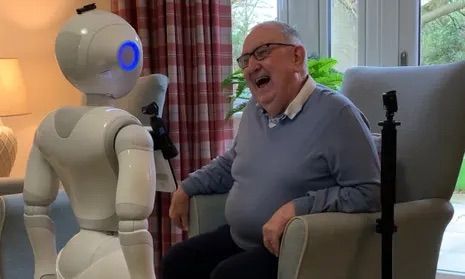
In the spirit of showing rather than telling, let's get into some real-world examples of how robots are making waves in elderly care. It's a bit like watching The Jetsons, but without the flying cars and conveyor belt sidewalks.First, let's zoom in on Japan, a country known for its advanced technology and aging population. They've been using a robot called Robear. This bear-faced robot (yes, you read that right) can lift patients from their beds and transfer them to wheelchairs.
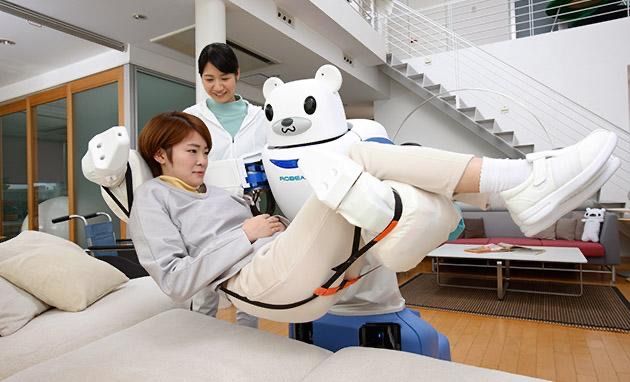
The result? A reduction in physical strain for human caregivers and a more comfortable experience for the patients. Plus, who wouldn't want to be lifted by a gentle bear robot?
An introductory robot called, GiraffPlus, a robot equipped with a video conferencing system that allows caregivers and family members to virtually visit seniors. This technology has allowed seniors to maintain social connections while also providing peace of mind to their loved ones.
The takeaway here? Sometimes, being able to see a familiar face, even on a screen, can make a world of difference.
These case studies underscore the transformative potential of robots in elderly care. They show us that technology, when thoughtfully designed and implemented, can enhance the human experience.
FUN/INTERESTING FACTS:
Robots come in all shapes and sizes: Did you know that one of the robots used in elderly care is shaped like a seal? PARO, a therapeutic robot designed in Japan, has a soft, furry exterior and responds to touch and sound, providing comfort and companionship to seniors.
The world's first social humanoid robot was named 'Pepper': Built by SoftBank Robotics, Pepper can recognize human emotions and respond accordingly. It's been used in various settings, including elderly care, to provide companionship and stimulate mental activity.
The origins of care robots date back to the 1960s: The first care robot, a wheelchair that could be controlled by the user's voice, was developed in the late 1960s. Since then, the field of robotics in elderly care has come a long way!
Care robots can reduce caregiver stress: Caregivers often experience high levels of stress due to the demanding nature of their work. Robots can assist with physically strenuous tasks, allowing caregivers to focus on providing emotional support and personalized care.
Robots can help combat loneliness: Many seniors experience feelings of loneliness and isolation, which can negatively impact their health. Companion robots can provide a sense of companionship, helping to alleviate these feelings.
Japan leads the world in care robotics: Due to its rapidly aging population, Japan has been a pioneer in developing and implementing robots for elderly care. In fact, the Japanese government actively supports the development of care robots through various initiatives and funding opportunities.
As we move forward, the key will be to continue learning, iterating, and adapting, all with the goal of ensuring our seniors live their best lives. Because at the end of the day, that's what it's all about, isn't it?
So, what does this future look like? For starters, we can expect to see an increase in the capabilities of care robots. We're talking about robots that can not only monitor health but also predict potential health issues before they become serious.
Picture a robot that can detect changes in a senior's gait and alert their caregiver to the risk of a fall. Now that's what I call proactive care!
In the words of the beloved Spock from Star Trek,
Quote: "Change is the essential process of all existence."
As we embrace the future of robotics in elderly care, let's ensure that this change is one that honors our shared human values and enriches the lives of our seniors.
As we gaze into the future, we see a horizon filled with innovative developments, groundbreaking capabilities, and emotionally intelligent companions.
It's a future that holds immense promise, but one that also demands thoughtful ethical considerations and the willingness to navigate potential challenges.
The integration of robots in elderly care is not merely about technological advancement.
It's about humanity.
It's about enhancing the golden years of our seniors, allowing them to live life to the fullest, and providing them with the care and companionship they deserve. After all, isn't that what we all aspire to in our later years?
As we move forward, let's do so with a spirit of innovation, a commitment to ethical practices, and most importantly, a heart full of empathy and respect for our seniors.Remember, in the words of The Iron Giant,
As we choose the path of robotics in elderly care, let's choose to be kind, compassionate, and human.



